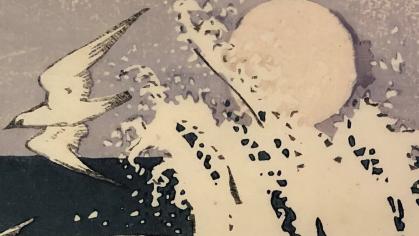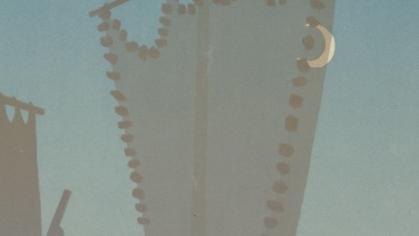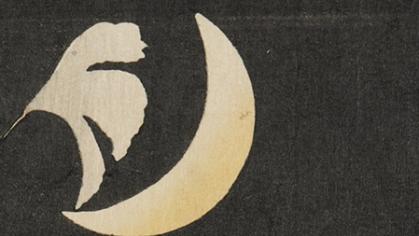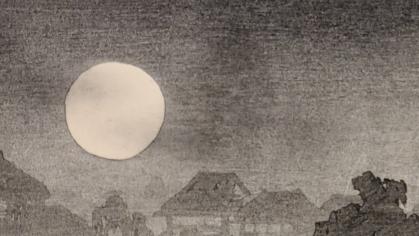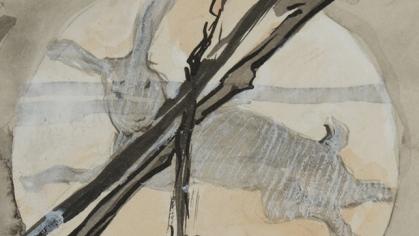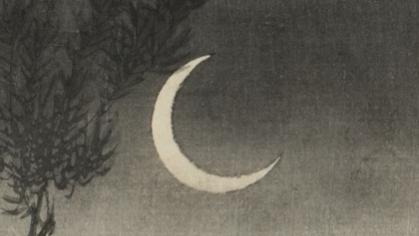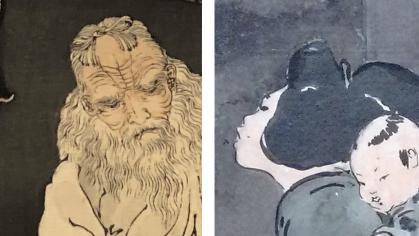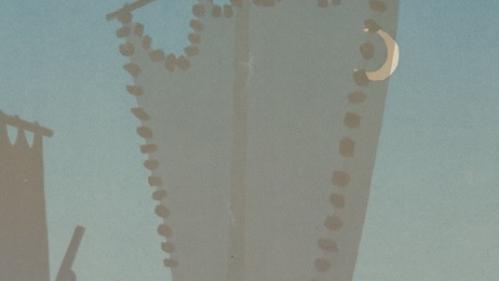
Shadow and Silhouette
Throughout the long history in Japanese visual arts, artists have used shadows and silhouettes to evoke the viewers’ memories and emotions. They would play with reflections and fashion configurations, alluding only to the forms of their subject matter by omitting finer details that would otherwise identify the subject. These obscure forms could help viewers access memories of their own personal experiences with a particular subject matter. The prints in this section are snapshots of everyday life that capture fleeting moments using motifs typical of ukiyo-e. The moon is the focal point that draws the viewer into the space surrounding it, creating a sense of intimacy in these presentations of simple human actions in relation with the ever present moon. Evoking emotions of calmness, loneliness, and mysticism, the moon allows a connection to form between the works and their audience. The changing phases and the lunar day are reflective of the constantly changing transient world and the rain, tides, and even our shadows are aspects which create a sense of motion and are expressive of human experience.
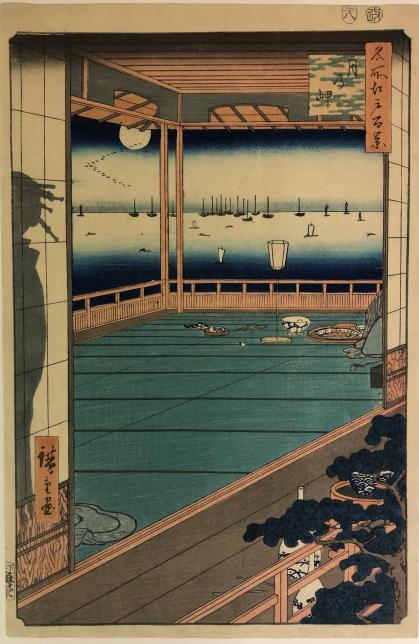
Moon-Viewing Point from the series One Hundred Famous Views of Edo
Color woodcut, 1857
Gift of David and Elizabeth Cayer
Utagawa Hiroshige 歌川広重 (1797-1858), born Andō Hiroshige, was considered the last great master of Japanese ukiyo-e. Moon-Viewing Point (Tsuki no Misaki 月の岬) is part of his series of prints, One Hundred Famous Views of Edo. This print, along with others in the series, introduces famous moon-viewing spots during the Edo period. Hiroshige's prints are prime examples of the depiction of the “floating world” (ukiyo 浮世) and revolve around theater, beautiful courtesans, city life, travel in romantic landscapes, and erotic scenes. Moon-Viewing Point shows a teahouse, under the glow of the seasonal autumnal full moon. The season is indicated by the triangular migratory formation of the birds flying nearby, a motif also seen in Takanawa. The moon casting the birds in shadow sets them within the same space as the moon, directing the viewer to contemplate the moon itself. The guests in attendance at this teahouse are being entertained by a performance of song and dance by the attending geisha, with a shamisen 三味線 (a three-stringed Japanese traditional instrument) to the left behind the kneeling geisha as well as what looks like a set up of a drinking game. With these details, it can be assumed that the setting is of the celebration of tsukimi 月見 (adoration of the moon).
As the positioning of the birds draws the viewer's eye to the moon, the moon's light exposes the outline of the geisha’s silhouette. In ukiyo-e, silhouettes were often shown through shōji 障子 paper screens, a common feature of Japanese homes. When lit by lamplight, the screens captured shadows of the people inside the homes going about their tasks, creating an impromptu shadow play. In this print, the moon plays the role of lamplight. The geisha is only alluded to, with her shape the only thing the viewer is able to ascertain and creates a sense of mystery that draws on this secretive world. Playing with the moonlight’s effect, Hiroshige captures a captivating and intimate aura in a single frame, in a space where only affluent men were able to admire the beauty of the moon overhead and associate it with the wafting of life’s worldly pleasures.
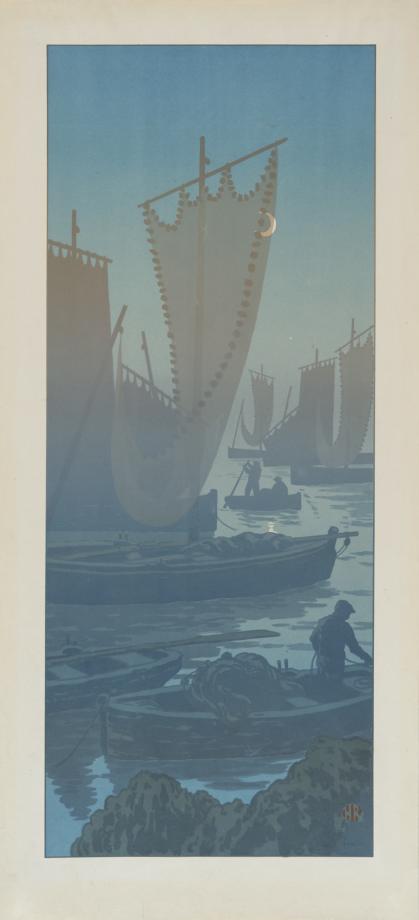
Le Premier Quartier (The First Quarter), from the series La Féerie des heures (The Enchantment of Hours)
Color lithograph, 1901
Gift of Sara and Armond Fields
This print is by Henri Rivière (1864-1951), a French artist. In the late 1880s, Rivière began experimenting with color woodcuts and lithographs. Le Premier Quartier (The First Quarter) comes from a series of sixteen color lithographs, called La Féérie des Heures (The Enchantment of Hours), printed between 1901 and early 1902. They are based on Rivière’s time spent in Brittany, France during the summers. Most of the prints from this series focus on the expansiveness of the seas and skies. Some were inspired by Japanese hanging scrolls (kakemono 掛け物 , kakejiku 掛け軸) and although the upright and narrow shape of this work offers only a narrow view of the landscape, the colors, lighting, and shadows lead the viewer’s eye up and down the image and create an encompassing view.
In this work, the moon is almost hidden by the sail, a recurring theme in traditional Japanese art of the almost “hidden” or “unseen” moon. The silhouette is suggestive of the moon’s brightness that creates shadows upon the water, boats, and people. In Japanese tradition, the first quarter moon (上弦の月 jōgen no tsuki), means “still waiting.” It is thought to be a very beautiful moon, as it grows anticipation, as waiting for the full moon, or waiting in anticipation for something to arrive or happen. This moon appears hazy and fading away and seems to be setting, as the sky is lit by the dawn. This represents the departure of the moon and the time when the people begin to awaken. We see the fishermen getting ready and heading out at dawn, waiting for their first catch of the day and anticipating the arrival of their bounty. The soft colors and hazy atmosphere combine with the first quarter moon to create something beautiful and calm, yet filled with expectation, and produces an intimate space within nature.
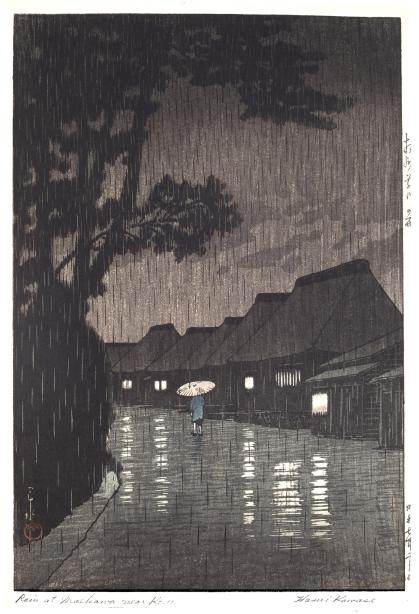
Rain at Maekawa in Sagami Province, from the series Selected Views of the Tôkaidô Road
Color woodcut, 1932
Gift of Elizabeth B. Reed
Rain at Maekawa in Sagami Province by Kawase Hasui 川瀬巴水 (1833-1957) is one of seven completed works for the unfinished series Selected Views of the Tōkaidō Road. Hasui was part of the shin-hanga 新版画 (new prints) movement, a twentieth-century movement that retained the traditional system of woodblock printing, in which the artist, carver, printer, and publisher collaborated to produce prints. Hasui visited locations and spent his time sketching scenes from morning until evening to produce landscape prints that focus on capturing atmospheric, natural scenes of tranquil beauty.
While the title of the print identifies an actual location, Maekawa village (present-day Odawara City, Kanagawa Prefecture), within the print the absence of any distinct elements tied to a specific location is a deliberate attribute of shin-hanga landscapes. Just as the location in the print is unknown without outside context, the woman in the print faces away from the viewer. Alone, she walks down a road towards an unknown destination. The lower area of the sky, near the unseen horizon, is of a lighter shade, uncovered by clouds. This indicates a light source and is suggestive of a specific type of moon in Japanese culture, amayo-no-tsuki 雨夜の月 (the moon on a rainy night). This moon is present even if hidden from sight, and traditionally represents longing for a lover that cannot be seen. As it reflects light, it also casts shadows onto the scene that accentuate the nighttime ambience. The shadows allude to the hidden, taking shelter under the cover of darkness and contributing to an air of mystery. The shadows merge the huts together and render the foliage into a black silhouette, obscuring both the path and the moon. The woman under the umbrella travels not only on a path that extends beyond our sight, but also approaches the moon. Though the woman’s identity is shielded by the umbrella and the moon is hidden behind the clouds, the relationship between the woman and the moon creates the mood of the print. As a symbolic subject, the moon often reflects the feelings conveyed by the scene and the state of the subjects within. A hidden moon may represent the inner nature of the woman. Since the woman appears relaxed and unhurried, it can be inferred that the woman has arrived at a point of understanding her place in the world. Through contemplation, she has found comfort and companionship in the duality of the moon and shadows, as well as the nature around them. Accompanied by the rain, the woman spends the passing moment walking leisurely in peace.
The moon, even if hidden from view, is a known presence in these prints. The moon takes on a leading role within the artworks, as the light the moon casts upon figures brings forward the importance of the lapse of time and individual moments. There are representations of recurring moments in a person's life, the reminders of the workings of daily life, and how the moon shows the passage of time. From this light emerges shadows and silhouettes, creating a sense of intimacy between those who exist in these moments. As the people in each work face towards the moon, even if not directly, it alludes to the contemplation occurring during these times of night, within these mysterious planes.
Irene Hu (‘22), Paisley Murray (‘23), Megan Williams (‘21)
Bibliography
Hutchison, Austin. "Henri Rivière: La Féérie Des Heures." Armstrong Fine Art. https://armstrongfineart.com/blogs/news/henri-riviere-la-feerie-des-heures.
Newland, Amy Reigle. Visions of Japan : Kawase Hasui’s Masterpieces. Amsterdam: Hotei Pub., 2004.
"Moonrise, Moonset, And Moon Phase In Bretagne, June 1901." Timeanddate.Com. https://www.timeanddate.com/moon/@3030288?month=6&year=1901.
"Print | British Museum." The British Museum. https://www.britishmuseum.org/collection/object/A_1906-1220-0-707.
Roman, Magali. "Invisible Tides: The Meaning of Moon Phases." Rikumo Journal. Accessed December 14, 2020. http://journal.rikumo.com/journal/the-meaning-of-moon-phases.
